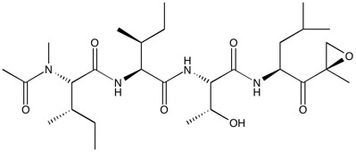Epoxomicin | Irreversible 20S proteasome inhibitor
NMR (Conforms)

Available Options
| size : | Price | Quantity | |
|---|---|---|---|
| 100 µg | $155.00 |
Epoxomicin (134381-21-8) is a potent, selective and cell permeable irreversible inhibitor of the 20S proteasome.1 It does not inhibit non-proteasomal proteases such as papain, chymotrypsin, trypsin, calpain and cathepsin B at concentrations up to 50 μM.1 Epoxomicin was isolated from Actinomycete strain Q996-17 and displayed in vivo antitumor activity against B16 melanoma cells.2 Epoxomicin caused a progressive model of Parkinson’s disease in various systems.3,4,5 This model has been disputed.6,7
References/Citations:
1) Meng et al. (1999), Epoxomicin, a potent and selective proteasome inhibitor, exhibits in vivo anti-inflammatory activity; Proc. Natl. Acad. Sci. USA, 96 10403
2) Hanada et al. (1992), Epoxomicin, a new antitumor agent of microbial origin; J. Antibiot. (Tokyo), 45 1746
3) McNaught et al. (2004), Systemic exposure to proteasome inhibitors causes a progressive model of Parkinson’s disease; Ann. Neurol., 56 149
4) Matsui et al. (2010), Proteasome inhibition in medaka brain induces the features of Parkinson’s disease; J. Neurochem., 115 178
5) Metcalfe et al. (2012), Coordination between proteasome impairment and caspase activation leading to TAU pathology:neuroprotection by cAMP; Cell Death Diff., 3 e326
6) Kordower et al. (2006), Failure of proteasome inhibitor administration to provide a model of Parkinson’s disease in rats and monkeys; Ann. Neurol., 60 264
7) Bove et al. (2006), Proteasome inhibition and Parkinson’s disease modeling; Ann. Neurol., 60 260
NMR (Conforms)
Safety Data Sheet:
Product Data Sheet:
Materials provided by Focus Biomolecules are for laboratory research use only and are not intended for human or veterinary applications. Please note that we do not sell to individuals and that all orders placed by non-research organizations will incur a $20 restocking/refund fee
Epoxomicin (134381-21-8) is a potent, selective and cell permeable irreversible inhibitor of the 20S proteasome.1 It does not inhibit non-proteasomal proteases such as papain, chymotrypsin, trypsin, calpain and cathepsin B at concentrations up to 50 μM.1 Epoxomicin was isolated from Actinomycete strain Q996-17 and displayed in vivo antitumor activity against B16 melanoma cells.2 Epoxomicin caused a progressive model of Parkinson’s disease in various systems.3,4,5 This model has been disputed.6,7
References/Citations:
1) Meng et al. (1999), Epoxomicin, a potent and selective proteasome inhibitor, exhibits in vivo anti-inflammatory activity; Proc. Natl. Acad. Sci. USA, 96 10403
2) Hanada et al. (1992), Epoxomicin, a new antitumor agent of microbial origin; J. Antibiot. (Tokyo), 45 1746
3) McNaught et al. (2004), Systemic exposure to proteasome inhibitors causes a progressive model of Parkinson’s disease; Ann. Neurol., 56 149
4) Matsui et al. (2010), Proteasome inhibition in medaka brain induces the features of Parkinson’s disease; J. Neurochem., 115 178
5) Metcalfe et al. (2012), Coordination between proteasome impairment and caspase activation leading to TAU pathology:neuroprotection by cAMP; Cell Death Diff., 3 e326
6) Kordower et al. (2006), Failure of proteasome inhibitor administration to provide a model of Parkinson’s disease in rats and monkeys; Ann. Neurol., 60 264
7) Bove et al. (2006), Proteasome inhibition and Parkinson’s disease modeling; Ann. Neurol., 60 260
Related Ubiquitin-Proteasome Pathway Products
Download
Calculate the molar concentration, mass or volume in a solution.
Concentration × Volume × Molecular Weight = Mass
Focus Biomolecules • Plymouth Meeting, PA USA • 1-855-FOCUS21
Focus Biomolecules
Plymouth Meeting, PA USA
1-855-FOCUS21
Website Created by Advanta Advertising LLC.

